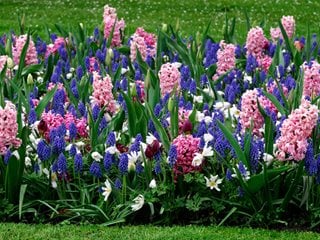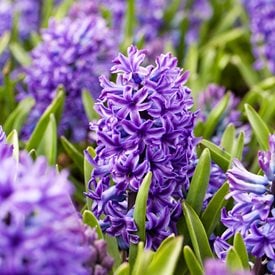Grow Hyacinth Flowers for Spring Color & Fragrance
Bring vibrant color and delightful fragrance into your spring garden with hyacinth flowers.Hyacinths are one of the easiest spring-blooming bulbs to grow. Although hyacinth plants are small, they pack a big punch of both color and fragrance in their clusters of blooms. There are many varieties available in several colors, including purple, white, yellow and pink. Hyacinth bulbs can be grown indoors as well as in your garden.
On this page: Basics | Planting | Care and Maintenance | Pictures | Design Ideas | Frequently Asked Questions
On this page:
- BASICS
- PLANTING HYACINTHS
- HYACINTH CARE AND MAINTENANCE
- HYACINTH VARIETIES
- DESIGN IDEAS
- FREQUENTLY ASKED QUESTIONS
BASICS
Zones:
Generally 3-9.
Height/Spread:
6 inches to 1 foot tall, 3 to 6 inches wide
Exposure:
Full sun to partial shade
Bloom Time:
Early to mid spring
Flower Color and Shape:
Single, double and multiflora blooms in shades of white, peach, orange, salmon, yellow, pink, red, purple, lavender, and blue.
Attracts:
Butterflies
PLANTING HYACINTHS
When to plant:
Plant hyacinth bulbs in fall, 6 to 8 weeks before a hard frost (usually September/October in the North and October/November in the South).
Where to plant:
Plant in a location that will receive full sun, with good drainage, as bulbs are prone to rot if the soil is too soggy.
How to plant:
Loosen the soil 12 to 15 inches down and add a layer of compost. Bulbs should be planted pointed end up, 6 to 8 inches deep, and 4 to 6 inches apart. Cover them with soil and press firmly. Water thoroughly when first planted.
Pre-chilling:
In warmer zones (7 and up), bulbs will need to be pre-chilled (out of the ground) for 8 to 12 weeks before planting. They can be placed in a protected outdoor shed or garage, or other dark area where temperatures are 35 to 45 degrees, but not below freezing. They can also be placed in the refrigerator, just not in the same location as fruit or vegetables, especially apples, as they produce a gas when ripening that causes the bulbs to rot.
Growing hyacinths indoors:
Hyacinths can be easily forced to grow and bloom indoors. After they have been pre-chilled for 8 to 12 weeks, they can be placed in potting soil, gravel, or ‘forcing jars’ — glass containers that look like an hourglass with the top cut off. Add water, just below the bulb and not touching it. Place the container in a dark, cool area and maintain the water level just below the bulb. After the roots begin to grow and foliage is about 2 inches tall, usually about 10 weeks, gradually acclimate to a sunny window over about a 4-day period. Once it begins to bloom, turn it slightly each day so it won’t grow leaning toward the sunlight.
Planting hyacinths in pots:
Planting in containers is ideal due to their compact size. Choose a container with good drainage holes. Add a layer of moistened potting mix to your container and place bulbs with their points up, close together, but not touching. Cover with potting mix, leaving just the tips of the bulbs exposed. Place in cool (25 to 50 degrees F), dark area until early spring. Gradually acclimate them to light over a few weeks, and move to full sun once they have produced a few shoots. Potted hyacinths can be grown indoors or outdoors.
Note: Wearing gloves is recommended when handling hyacinth bulbs, as they have been known to cause an itchy skin reaction in some people.
For more on how to plant bulbs:
Bulbs 101: Planting and Storing Bulbs
HYACINTH CARE & MAINTENANCE
Water:
Bulbs should be watered thoroughly at the time of planting in the fall. Soil should be kept slightly moist through the fall into winter, with light watering only if there is no rainfall. The ground should be allowed to dry out in between in order to prevent bulb rot. Watering should begin again when growth appears above ground and taper off after blooming as the bulb progresses to dormancy.
Soil:
Hyacinths prefer moderately fertile, well-drained soil.
Pruning:
After flowering, cut the flower stalk back to keep the bulb from expending energy to produce seeds. The foliage should be left intact, allowing the plant to continue to produce and store energy for next season. Leaves should be left until they die back naturally and then can be removed.
Propagation:
Hyacinth bulbs will spread and multiply if left in the ground to return the next year; however, they will generally only last 3 or 4 years.
Fertilizer:
Applying a layer of compost annually should provide adequate nutrients.
Diseases and Pests:
Hyacinth bulbs can be prone to gray mold and bulb rot. Rodents can be a menace. A handful of gravel placed in the planting hole can sometimes discourage them from chomping on your bulbs. Also, planting hyacinths amongst daffodils can also deter them, as they tend to avoid daffodils.
Overwintering hyacinths:
In colder zones, bulbs can be left in the ground, provided they have some winter protection (a layer of mulch) in Zone 5 or lower.
In warmer zones (7 and up), they will need to be dug up, stored, and pre-chilled before planting the following fall. After blooming, wait until the leaves die back completely before digging up the bulbs. Remove as much dirt as possible and lay them out on newspaper for 3 to 4 days in a cool, dark spot. Store them in a mesh bag or a cardboard box with holes, pack with shredded paper.
HYACINTH VARIETIES
DESIGNING WITH HYACINTHS

In this mixed border hyacinths are combined with other spring bloomers including muscari, anemone and tulips. Photo by: RM Floral / Alamy Stock Photo.
Here are some ways to incorporate hyacinth flowers into your garden:
- Due to their small size, hyacinths are best planted in groups in beds, borders, or rock gardens.
- Their small shape and spiky stalks mix well with other spring bulbs, providing contrast to taller tulips and daffodils.
- Plant them near walkways, entries, or patios to enjoy their scent.
- Plant them in pots outdoors and then bring inside just before blooming to provide a natural, indoor air freshener.
FREQUENTLY ASKED QUESTIONS
What about grape hyacinth? Common grape hyacinth (Muscari botryoides) is related to common hyacinth (Hyacinthus orientalis), but is from a different genus. How do you tell them apart? Common hyacinth has blooms that are star-shaped and open fully, while common grape hyacinth has tight blooms in a raceme that resemble clusters of grapes.
Are hyacinths poisonous? Hyacinths are known to be toxic if consumed by humans or animals and are listed on the ASPCA website as toxic to dogs, cats, and horses. The concentration of toxin is greater in the bulb than in the flowers or foliage. More severe cases of poisoning occur when animals dig up freshly-planted bulbs or discover a bag of them before planting. Some people experience an itchy skin reaction from handling the bulbs, so wearing gloves is recommended. See more Common Poisonous Plants for Dogs and Cats.
Are hyacinths deer resistant? They are considered to be highly resistant to deer, as deer tend to steer clear of plants or flowers with strong scents.
Are hyacinths perennials? They can be used as perennials, as they will return each year if left in the ground in certain zones. However, in warmer zones they can be treated more like annuals, as they will need to be dug up to be pre-chilled before planting again in the fall.
RELATED:
Top 20 Spring-Blooming Bulbs
All-Star Spring Flowers
20 Fragrant Flowering Plants

















